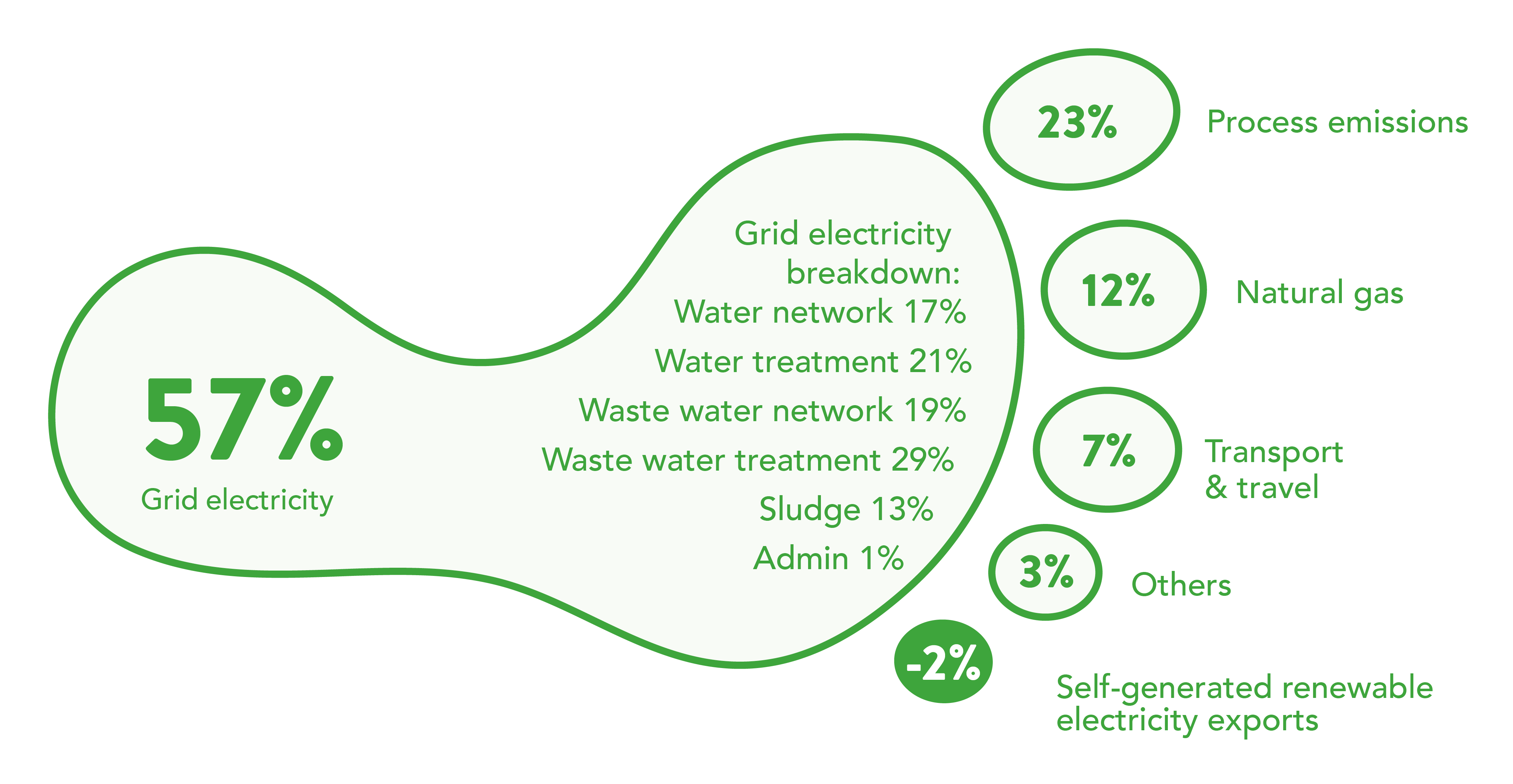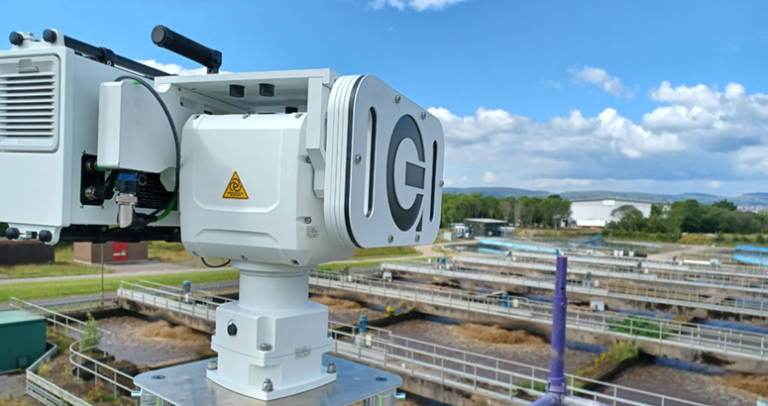YEAR FOUR OVERVIEW
We successfully delivered over 12,000 tCO2e of carbon reductions in Year 4 of our Net Zero Routemap (2023/24).
Our annual operational greenhouse gas emissions – our carbon footprint – rose slightly to 225,000 tCO2e during 2023/24 due to a rise in the carbon intensity factor of grid electricity used in the calculations.
Nevertheless, our actions are resulting in an overall downward trend for our operational emissions and we remain on track to deliver net zero before 2040.
We continued to make progress across all areas of our routemap and delivered actions which eliminated, reduced or captured emissions.
Highlights include:
We continue to focus on developing our knowledge to identify and maximise future opportunities and we continue to review our progress and learn from our experiences.
We have improved our processes, skills and communication approaches around woodland planting and peatland restoration enabling larger areas to be restored and planted this year. We are looking to continue to mitigate against weather (notably winter storms) and commercial challenges by identifying and bringing forward larger numbers of candidate projects at the initial stages.
This year our renewables programme was impacted by the ability to retain people in a very active recruitment environment as the UK grew its renewable capacity. We are looking to address this through the implementation of a new reward framework.
In 23/24 we paused the development of any new solar PhotoVoltaic (PV) schemes whilst we worked to establish an ethical supply chain. To continue to support our renewable energy generation targets we have examined alternative PV opportunities and wider renewable energy prospects such as wind and hydro power and continue to build our capabilities in these areas.
We have recognised that we need to expand our knowledge and capabilities around the installation of process emission monitors in our activated sludge waste water sites and their data connectivity with our existing digital systems. We are therefore increasing our resourcing in this area.
To reinforce the management, continuous improvement and learning required to embed net zero across all we do, we have commenced reviews and audits towards accreditation with the revised PAS2080 (Publicly Available Specification) for carbon management. We hope to achieve accreditation by next year.
We can only achieve our Beyond Net Zero ambition by working in partnership and we are continuing to strengthen and expand our activities in this area.
Our 10 year land management plan for Loch Katrine with Forestry and Land Scotland (FLS) has now been approved by Scottish Forestry (SF) which will support the capture up to 1 million tCO2e over the next 60 years on 4,600 hectares by planting and regenerating woodland and restoring peatland over the coming years.
We have partnered with the Royal Botanic Garden Edinburgh on their ‘plants with purpose’ programme to examine and optimise planting schemes to support carbon reduction in blue green infrastructure projects such as rain gardens and storm water planters.
We are expanding our woodland creation to support the Clyde Climate Forest with 60-70 hectares at three woodland areas planned for this year with 19 hectares woodland already created adjacent to the Clyde Climate Forest boundary.
To support the growing hydrogen economy, our business arm Scottish Water Horizons is partnering with stakeholders and production companies on over 40 projects across the country with a potential hydrogen capacity of over 3 GWh. Scottish Water Horizons provide hydrogen feasibility assessments, design, build and operation, and maintenance services on a range of water sources. This includes potable treated water, untreated raw water and final effluent from waste water.
Our commitment to partnership has led to Scottish Water to join the Edinburgh Climate Compact which will also support our existing membership of the Glasgow Climate Compact.
Finally, our Low Carbon Concrete Collective (LCC) with Network Rail, SSE, Scottish Power and Transport Scotland is continuing to make progress. The Collective was established in 2022 to accelerate the development, availability and adoption of the next-generation of low carbon concrete in Scotland and are progressing the design and pilot of:











If you would be interested in partnering with us for example to:
Please contact our Net Zero team at: SWNetZero@scottishwater.co.uk.
To encourage knowledge sharing, our Net Zero Heroes network is going from strength to strength.
We now have over 60 people meeting together regularly from Scottish Water and our supply chain partners to share best practice. It includes people who have enabled and implemented carbon savings and carbon capture opportunities and others who have improved Net Zero reporting or delivered an exemplary project to help us with our sustainability ambitions. We have also initiated work with some of our key equipment suppliers to better understand how their products will decarbonise over time. This has allowed us to update our pathway to Net Zero investment emissions, which we forecast delivering for 2040.
We have been externally recognised for our work receiving a Distinction for the Net Zero Carbon Champion at the Global Water Awards, and we have also been recognised as one of the most inspiring utilities in the Achiever category of International Water Association’s 2024 Climate Smart Utilities Recognition Programme.


We continued to make progress across all areas of our routemap and delivered actions which eliminated, reduced or captured emissions.
Highlights include:
We continue to focus on developing our knowledge to identify and maximise future opportunities and we continue to review our progress and learn from our experiences.
We have improved our processes, skills and communication approaches around woodland planting and peatland restoration enabling larger areas to be restored and planted this year. We are looking to continue to mitigate against weather (notably winter storms) and commercial challenges by identifying and bringing forward larger numbers of candidate projects at the initial stages.
This year our renewables programme was impacted by the ability to retain people in a very active recruitment environment as the UK grew its renewable capacity. We are looking to address this through the implementation of a new reward framework.
In 23/24 we paused the development of any new solar PhotoVoltaic (PV) schemes whilst we worked to establish an ethical supply chain. To continue to support our renewable energy generation targets we have examined alternative PV opportunities and wider renewable energy prospects such as wind and hydro power and continue to build our capabilities in these areas.
We have recognised that we need to expand our knowledge and capabilities around the installation of process emission monitors in our activated sludge waste water sites and their data connectivity with our existing digital systems. We are therefore increasing our resourcing in this area.
To reinforce the management, continuous improvement and learning required to embed net zero across all we do, we have commenced reviews and audits towards accreditation with the revised PAS2080 (Publicly Available Specification) for carbon management. We hope to achieve accreditation by next year.
We can only achieve our Beyond Net Zero ambition by working in partnership and we are continuing to strengthen and expand our activities in this area.
Our 10 year land management plan for Loch Katrine with Forestry and Land Scotland (FLS) has now been approved by Scottish Forestry (SF) which will support the capture up to 1 million tCO2e over the next 60 years on 4,600 hectares by planting and regenerating woodland and restoring peatland over the coming years.
We have partnered with the Royal Botanic Garden Edinburgh on their ‘plants with purpose’ programme to examine and optimise planting schemes to support carbon reduction in blue green infrastructure projects such as rain gardens and storm water planters.
We are expanding our woodland creation to support the Clyde Climate Forest with 60-70 hectares at three woodland areas planned for this year with 19 hectares woodland already created adjacent to the Clyde Climate Forest boundary.
To support the growing hydrogen economy, our business arm Scottish Water Horizons is partnering with stakeholders and production companies on over 40 projects across the country with a potential hydrogen capacity of over 3 GWh. Scottish Water Horizons provide hydrogen feasibility assessments, design, build and operation, and maintenance services on a range of water sources. This includes potable treated water, untreated raw water and final effluent from waste water.
Our commitment to partnership has led to Scottish Water to join the Edinburgh Climate Compact which will also support our existing membership of the Glasgow Climate Compact.
Finally, our Low Carbon Concrete Collective (LCC) with Network Rail, SSE, Scottish Power and Transport Scotland is continuing to make progress. The Collective was established in 2022 to accelerate the development, availability and adoption of the next-generation of low carbon concrete in Scotland and are progressing the design and pilot of:











If you would be interested in partnering with us for example to:
Please contact our Net Zero team at: SWNetZero@scottishwater.co.uk.
To encourage knowledge sharing, our Net Zero Heroes network is going from strength to strength.
We now have over 60 people meeting together regularly from Scottish Water and our supply chain partners to share best practice. It includes people who have enabled and implemented carbon savings and carbon capture opportunities and others who have improved Net Zero reporting or delivered an exemplary project to help us with our sustainability ambitions. We have also initiated work with some of our key equipment suppliers to better understand how their products will decarbonise over time. This has allowed us to update our pathway to Net Zero investment emissions, which we forecast delivering for 2040.
We have been externally recognised for our work receiving a Distinction for the Net Zero Carbon Champion at the Global Water Awards, and we have also been recognised as one of the most inspiring utilities in the Achiever category of International Water Association’s 2024 Climate Smart Utilities Recognition Programme.


PROGRESS IN YEAR
During 2023-24 we made good progress across all 4 key strategic activity areas of our routemap:
BECOMING MORE
ENERGY EFFICIENT
Saved 5.68 GWh of electricity in our water and waste water services through energy efficiency projects.
Saved over 0.46 GWh of energy so far through the installation of best efficiency point control at five of our largest pumping stations.
USING LOWER-CARBON
ENERGY PRODUCTS
Completed 13 renewable energy projects with a generating capacity of 5.8 GWh.
Installed Scotland’s first containerised hydropower scheme at Hamilton Waste Water Treatment Works generating c. 0.42 GWh of electricity.
Added a further 214 electric vehicles to our fleet giving us 473 in total and expanded our number of charging points to 291.
Deployed sustainable hydro-treated vegetable oil (HVO) reducing our diesel emissions by up to 90% with our investment programme partners.
embracing low
carbon construction
Adopted low carbon steel reinforcement (Rebar) products with c. 50% lower CO2e content. Approximately 12% of our construction emissions are associated with Rebar products and therefore a reduction of 5-6% of our total construction emissions is now possible.
Started the development of low carbon concrete pilots – a pre-cast low carbon concrete manhole ring, a structural foundation and a pre-cast cable trough using a ground granulated blast-furnace slag (GGBS) blend with Recycl8’s bottom ash aggregate using landfill waste embracing the circular economy.
storing away emissions that
cannot be avoided
Restored a record 316 hectares of peatland in our water catchments capturing over 6,000 tCO2e alongside improving raw water quality.
Planted 66 hectares of native broadleaf woodland with oak, alder, hawthorn, rowan and birch trees.
Confirmed the establishment of 507 hectares of natural woodland regeneration at Loch Katrine.
Published the contribution of our woodland creation and peatland restoration programmes to biodiversity in our triennial Biodiversity Report which set out our first natural capital accounts and presented our biodiversity baseline.
KEY OBJECTIVES FOR 2024/25
Our Year 5 plan is to further increase our rate of delivery and deliver more carbon reduction than was achieved in 2023-24.
We will act across all key strategic goals in our routemap to:
OPERATIONAL CARBON FOOTPRINT 2023/24
GREENHOUSE GAS EMISSIONS BY SOURCE

Our annual operational greenhouse gas emissions – our carbon footprint – rose slightly to 225,000 tCO2e during 2023-24.
Whilst we continued to make good progress on energy efficiency and renewables, rises in the carbon intensity of grid electricity, contributed to a 2.3% (5,000 tCO2e) increase compared with the previous year3.
Nevertheless, our actions are resulting in a continued downward trend for our operational emissions and we remain on track to deliver net zero before 2040.
To do this we need to progress hosted wind farms on our land, invest in new technology to replace ageing sludge drying facilities and for the electricity grid to decarbonise. These, along with current intelligence on progress of process emissions reductions and forecast increase in carbon capture on our land show that we should achieve operational Net Zero in the mid-2030s.
As in previous years the footprint was verified externally to ISO 14064-1.
The continued greening of the grid coupled with increased energy efficiency and renewables delivery has made a significant contribution to our progress, but at 57% of emissions, electricity remains our biggest source.
At 23% process emissions from waste water treatment are the next biggest source, which is driving much of the focus on innovation and research to minimise these emissions in the future.
3 Our reported 2022-23 carbon footprint was found to contain an error that slightly under-reported the amount of electricity consumed by several PFI schemes. The revised 2022-23 footprint is 220,000 tCO2e, a 1% increase on what we previously reported.
PROGRESS UPDATE
We have highlighted key milestones on the way to net zero in our routemap which covers all aspects of our emissions. Our milestones are supported by a range of actions and activities to build capacity and capability which we undertake to deliver specific goals over defined timescales to reach net zero.
Progress across our goals can be viewed in the sections below.
Electricity consumption is still our largest single source of emissions at 57%. We must reduce our consumption to reduce emissions and increase financial benefits, while enabling us to support other goals such as generating all the electricity we consume.
GOAL: Reducing our consumption of electricity – Goal 20% by 2040
GOAL: 100% of energy used is our own or hosted renewables by 2040
Process emissions, particularly nitrous oxide (N2O) remain the most challenging area for the water sector to address, requiring a focus on the science, measurement and management of emissions, as well as on technologies to reduce or eliminate the production of emissions.
GOAL: 20% reduction
Reducing our reliance on fossil fuels across all of our sites is a key part of getting to net zero.
GOAL: 100% reduction in gas and fuel oil consumption
Key Achievements:
Our fleet travelled around 18.4 million miles for business reasons. This was equivalent to the previous year. Our strategy aims to minimise the miles we travel and find zero emissions ways to travel.
GOAL: 50% reduction in the distance we travel
GOAL: 100% Zero Emissions Fleet
We were the first UK water company to include investment emissions as part of our net zero goal. Now that our operational emissions have reduced investment emissions are now our biggest source of emissions each year.
GOAL: 75% reduction in carbon intensity of investment
GOAL: 75% reduction in carbon intensity
Across the 23,219 hectares of our land, we can contribute to the natural, social and economic sustainability of Scotland’s landscape by working to increase carbon storage and biodiversity
GOAL: Improve carbon dioxide storage on our land to support net zero emissions
Electricity consumption is still our largest single source of emissions at 57%. We must reduce our consumption to reduce emissions and increase financial benefits, while enabling us to support other goals such as generating all the electricity we consume.
GOAL: Reducing our consumption of electricity – Goal 20% by 2040
GOAL: 100% of energy used is our own or hosted renewables by 2040
Process emissions, particularly nitrous oxide (N2O) remain the most challenging area for the water sector to address, requiring a focus on the science, measurement and management of emissions, as well as on technologies to reduce or eliminate the production of emissions.
GOAL: 20% reduction
Reducing our reliance on fossil fuels across all of our sites is a key part of getting to net zero.
GOAL: 100% reduction in gas and fuel oil consumption
Key Achievements:
Our fleet travelled around 18.4 million miles for business reasons. This was equivalent to the previous year. Our strategy aims to minimise the miles we travel and find zero emissions ways to travel.
GOAL: 50% reduction in the distance we travel
GOAL: 100% Zero Emissions Fleet
We were the first UK water company to include investment emissions as part of our net zero goal. Now that our operational emissions have reduced investment emissions are now our biggest source of emissions each year.
GOAL: 75% reduction in carbon intensity of investment
GOAL: 75% reduction in carbon intensity
Across the 23,219 hectares of our land, we can contribute to the natural, social and economic sustainability of Scotland’s landscape by working to increase carbon storage and biodiversity
GOAL: Improve carbon dioxide storage on our land to support net zero emissions
ENABLERS
We cannot achieve our ambitious goals alone and we assume that required future investment funding is available. On our journey to net zero there are some key enabling activities which we have progressed in the last year.
PEOPLE
CUSTOMERS AND COMMUNITIES

PROCUREMENT
GOVERNANCE
POLICY AND REGULATION

INNOVATION

LOW ENERGY WATER
AND WASTE WATER
TREATMENT,
AMMONIA AND
METHANE RECOVERY
DIGITAL AND
ANALYTIC TOOLS
MATERIALS
RESEARCH
WATER FOR
HYDROGEN
PRODUCTION
Our Exemplar Waste Water Pumping Stations Transformation project has implemented best efficiency point control at five of our largest pumping stations. We have also connected the asset to the Xylem Avensor portal which allows for 24/7 remote monitoring of the station, allowing our operators to prioritise important operational issues. So far over 0.46 GWh of energy has been saved and this will increase as we optimise the further 30 stations in scope.
We have worked with Cobalt Water to grow our understanding of these technically challenging process emissions. From our results at sites in Glasgow it is becoming clear that nitrous oxide emissions which are currently calculated on a per capita basis are very site specific.
Braidholm
We have started to see the use of recycled aggregates on our sites. George Leslie at Braidholm worked with WH Malcolm to adopt recycled aggregate. 600 tonnes of secondary (recycled) aggregates as bedding material for pipes and hardstanding, and 225 backloaded tipper wagons removing 4,000 tonnes of excavated material for recycling was achieved. With concrete being one of the construction industry’s biggest carbon emitters, the Braidholm Road team used 400 m3 low carbon concrete (40% less CO2e). Other innovations employed included low energy welfare units, using temporary “fluming” of sewers saving 32 days over pumping, monitoring plant and vehicle idling times, monitoring vehicle driving styles, and trialling the using of small mobile battery power units for small plant. The total carbon saved was approximately 220 tCO2e
Recently we have also seen what Brewster Bros can deliver, including producing recycled sand for concrete and also providing EPDs for all their recycled aggregates.
Supplying Water for Hydrogen
Hydrogen is a key fuel in the wider Net Zero transition, and water is a key component. To support the growing hydrogen economy, our business arm Scottish Water Horizons is working with stakeholders and production companies on over 40 projects across the country with a potential hydrogen capacity of over 3GW. We are working with them to provide feasibility assessments, design, build and operation, and maintenance services on a range of water sources. This includes potable treated water, untreated raw water and final effluent from waste water.
WASTEWATER ANAEROBIC TREATMENT TRIAL
We have developed a design for the anaerobic treatment of waste water and have installed a pilot reactor at our Denny waste water treatment works.
This will undergo a year long trial to test its effectiveness under a range of operating conditions. If successful, we will look to scale up the technology. This technology offers the potential for a waste water treatment works to not only be low energy but also to generate all the energy it consumes.
FLOW ENERGY
To help reduce energy consumption across our 2500 sewage pumping stations, we have developed a tool called Flow Energy which uses energy consumption data and digital algorithms to identify potential issues.
This enables local teams to investigate sooner and put in place interventions to prevent service failure and reduce excess energy demand.
So far this has been deployed to over 1,400 sewage pumping stations, providing weekly reports to team leaders from across the country and could help save around 5% of energy demand in waste water pumping over the coming years.
CEMFREE / ROAD
BINDER TRIALS
At Daldowie Waste Water Treatment Works
we have trialled a low carbon concrete alternative called Cemfree.
This can be used in place of cement to from a concrete with up to 80% less embodied carbon. With our delivery partners, we are looking at how we might make greater use of this type of material.
At Biggar Water Treatment Works, we worked
with McKenzie Construction to resurface an 800 metre section of access road by using a binder called ecoProactive to stabilise the existing surface. This process was cheaper than tarmacking the road and eliminated the need for quarrying and delivering new materials.
HYDROGEN FROM
FINAL EFFLUENT
Working with Cranfield University, we are studying the role of hydrogen in reducing carbon emissions in the industry.
This study looks at the technologies and processes available to produce hydrogen and what role these can play in reducing emissions.
Repairing and maintaining treated Water Storage tanks in our networks across the whole of Scotland is responsible for c. 10% of the spend on our water treatment works and networks each year. Given the repeatability of site set up’s for this work MacKenzie Construction Limited (MCL) investigated the lowest carbon site set up.
Burghmuir treated water storage tank repair in Perth, had a 42 week work programme, MCL adopted – aluminium track panels for the access road, eco welfare units, hybrid power generator, HVO to replace diesel and used a hydrogen powered site security system.
By comparing a traditional site set up with the set up at Burghmuir, MCL achieved a 97% reduction in CO2e emissions saving 126 tCO2e and a £43k reduction in costs. 70% of the site establishment used hybrid power.
This set up is now BAU across our sites.
10 new electric vans have been delivered to Customer Water Services (CWS) and Electrical and Mechanical (E&M) operational teams in Orkney, across Westray, Sanday, Eday, North Ronaldsay and the Orkney Mainland. To support the transition, electric vehicle (EV) charging points have also been fitted at operational sites including Boardhouse Water Treatment Works (WTW) Kirkwall Waste Water Treatment Works (WWTW) and Bu-Point WWTW, with another 5 site installations in progress. All operatives are very pleased with the new EV driving experience and pioneering for the greener environment.

Scottish Water Horizons has delivered an innovative hydropower scheme at Hamilton waste water treatment works. This project signifies a significant leap forward for the industry, achieving several notably milestones. Firstly, it marks the UK’s first mid-process waste water installation which maximises energy potential. It is also Scotland’s first containerised hydropower installation, delivering dual benefits of reducing construction emissions whilst saving time and costs. This project reduces our reliance on imported grid electricity and minimises on-site energy expenses. The scheme is estimated to produce 0.42 GWh of green electricity annually, offsetting approximately 14% of the site’s yearly energy demand and mitigating around 64 tCO2e annually.
This year we achieved a key milestone for our plans to improve carbon capture and biodiversity at Loch Katrine, the source of water for Greater Glasgow. We have been working closely with Forestry and Land Scotland to prepare a 10-year land management plan for the 9500 ha estate around the loch and this has now been submitted to Scottish Forestry for approval.
The plan looks at how we increase tree cover and biodiversity and focuses on natural regeneration using Scottish native trees including birch, rowan, oak and alder. This approach has a minimal impact on the catchment and water quality. We will also be restoring peatland at the site.
The project is set to deliver a 40% increase in biodiversity on the estate and capture nearly a million tonnes of carbon over the next 60 years.
Scottish Water installs many glass reinforced plastic kiosks on its assets to house a wide variety of equipment- from chemical dosing skids to electrical panels. There is a high carbon content in the kiosk- often more than the equipment in the kiosk. Two of our construction partners have been exploring alternative low carbon materials. Three new kiosk types have now been designed and built with low carbon materials and we are starting to deploy them on projects. One is made from recycled plastic bottles, one is made from engineered timber and the third is made from light gauge steel. The carbon reduction ranges from 60 to 85%, depending on the material used and the security rating of the kiosk. As well as being used by Scottish Water, other utility companies are also looking to use them on their projects.
Scottish Water has established a framework for the supply of sustainably sourced hydrotreated vegetable oil that can be used by both Scottish Water and its construction partners. It’s a drop in fuel replacement that reduces emissions by 90% compared to conventional diesel.
Over the last year it has been widely adopted by our construction partners, displacing diesel use in excavators, cranes and other heavy plant. It is also being used to fuel generators to provide power for remote construction sites.
On our water mains rehabilitation programme its adoption is expected to reduce emissions by nearly 30%.